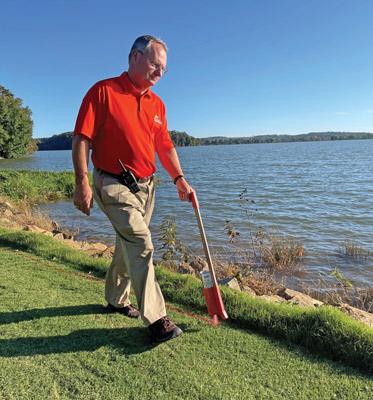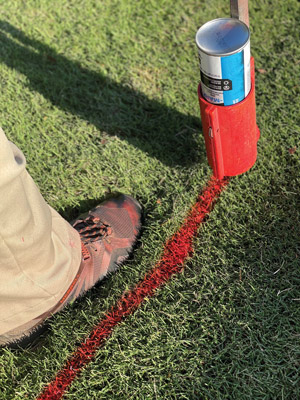Who is responsible at your golf course for marking and staking the penalty and out-of-bounds areas?
Traditionally, this has been the responsibility of the golf shop staff, but I’d argue this job should be the responsibility of the golf course superintendent. Yes, the pro shop staff is responsible for the enforcement and interpretation of the Rules of Golf, but the superintendent is responsible for the upkeep and maintenance of the course itself. I believe this should extend to the marking and painting of the penalty areas and out of bounds of the course as well.
To me, this makes sense for the following reasons:
1. Better coordination between the mowing and painting schedules. The superintendent knows the mowing schedule and can paint following the last mowing of the rough for that week, allowing the paint to be at its brightest and most visible for a weekend event. If the pro shop staff were to do it, they might need to paint early in the week when the workload might be lighter before the big event. By doing it earlier in the week, much of the paint may be mowed off throughout the course of the week, resulting in a less-than-ideal appearance. Asking the pro shop staffers to wait might not be feasible, as they might be busy with last-minute preparations later in the week.

Right: Who better to mark the golf course for play than its head caretaker, knowledgeable of every nook and cranny? Author Don Garrett, CGCS, superintendent at the Walker Course at Clemson University in Clemson, S.C., has found several advantages to handling the duties himself. Photos by Mary Cate Garrett
2. Marking the course demonstrates a knowledge of the game and the rules that govern it. I took an interest in marking the golf course after studying the Rules of Golf for the GCSAA certification exam. When I was certified in 1995, the Rules made up an entire section of the exam. Not having played a lot of golf, I spent a lot of time studying this section and asked the golf professional whether I could help mark the course in order to gain a better understanding of this aspect of the Rules. I enjoyed it so much, I started doing it all the time. I also feel it adds to the professionalism of the superintendent’s role. It shows we aren’t just grass growers: We understand the game, the Rules and the playing field on which it is contested.
3. It’s an excellent way to see the entire course. Marking the course gets me off the beaten path, if you will. I get to see every part of the course, including many out-of-the-way areas. I can fill up a notepad with things I find that need to be addressed that I might not have noticed otherwise — even on a course-inspection ride — such as low limbs that need trimming, encroaching underbrush and broken sprinklers, to name just a few. There are a lot of abandoned golf balls in these areas as well, so my golf bag is full after a round of painting.
4. Good fences make good neighbors. Keeping the out-of-bounds areas properly marked keeps the property boundaries around the course clearly defined. Knowing what is golf course property — and what isn’t — is important, especially on golf courses with surrounding homes or development. Keeping the boundary properly staked can minimize disputes over whose property is whose when it comes to not only golf play but also to maintenance items such as mowing, pest control and the removal of dead trees or debris, which can directly affect the superintendent and his or her staff. From my experience, I have found a sturdy stake well anchored in the ground works best. I have had homeowners move the OB stakes to their benefit, either away from their property to keep golfers away, or closer to their property in the hope that the maintenance staff will do mowing and upkeep on their land.
5. Marking the course allows you to position stakes where they might be easier to mow around. There is some leeway in the Rules as far as exactly where a stake goes. I attempt to position them correctly while at the same time making it easier for my mowers to navigate. Just a couple of feet laterally or a few inches vertically can have a big impact on whether a mower can make it around a pond edge, and the placement can still conform to the Rules and allow a player full relief. And if painted regularly, the line defines the hazard or penalty area; the stake only denotes it. If the pro shop staff is marking the course, the impacts of a stake upon mowing likely won’t be considered.
6. Staff accountability. I have found that we have fewer stakes run over by mowers when I mark the course. When an employee “accidentally” hits a stake with a mower and destroys it, he or she is accountable to their boss, the superintendent, as opposed to someone in the pro shop whom they may not know. They realize I will know which mower and which operator were responsible for mowing in certain areas, and I can easily put two and two together. And if they don’t realize it, they soon will.
7. It’s good exercise. I don’t like the look of a wobbly line painted while riding along in a golf cart, so I prefer to walk when painting hazards and penalty areas. Talk about a good workout. It takes me about a day to a day and a half, four cases of marking paint and 40,000 steps to paint my course.
8. Family time. Our lives as golf course superintendents can get hectic with long hours, especially during the growing season, and we often don’t find enough time to spend with our families. Fortunately, my wife likes spending time with me at the course. Some evenings, we go back in after dinner and paint a few holes behind play. It’s a great time to be on the course, as the sun is going down and the irrigation starts up, and I have someone to drive the cart and shake cans as I walk along and paint. When my son was in school and worked for me, he would drive along and stop to pound in stakes as we went.

The sun sets on the 17th hole at the Walker Course at Clemson University, where author Don Garrett has served as superintendent since 1999.
9. Stay in touch with the schedule. Being responsible for marking the course helps me stay on top of the golf events calendar. I do a better job of recognizing what events are coming up knowing that I need to have the course freshly marked, and it also helps me see that proper agronomic practices are accomplished in a manner that prevents any negative effects on the event.
10. Improve the golf professional/superintendent relationship. Want to improve your relationship with your golf professional? By offering to take over the marking of the course, you’re all but guaranteed to get on his or her good side!
I know many will say, “I’m too busy as it is and don’t have the time to take on this additional responsibility.” For some that may be true, but I’d counter that by saying that you are already on the course every day. Stop and paint a little bit here and there as you are inspecting the course and supervising your staff. Consider all the points I’ve made above and see whether it would be a benefit to you as well.
Tips for golf course marking success
Think you might want to give it a try? Here are a few tips to help you out.
1. Mark the course with your golf professional the first couple of times. Work with him or her to learn/decide the proper way to mark your course if you are unsure. Take good notes, and maybe even mark up an aerial map of your course to use as a guide if the paint wears off between events.
Editor’s note: Ever wished you had a bird’s-eye view of your golf course? This primer on drones on the golf course will propel you through the basics of such technology and how you can capitalize on the collected images and data.
 2. Have a special set of shoes for painting. Your shoes are going to get paint on them (see mine at right), so go ahead and sacrifice a pair. Designate an older pair of comfortable shoes or boots for this job. Better yet, designate two pairs: a pair that’s waterproof and one that isn’t. That way, you can paint in the morning when there’s dew on the ground, and in the afternoon when it’s dry. And don’t wear your favorite pair of pants. Trust me, you’ll get paint on them as well.
2. Have a special set of shoes for painting. Your shoes are going to get paint on them (see mine at right), so go ahead and sacrifice a pair. Designate an older pair of comfortable shoes or boots for this job. Better yet, designate two pairs: a pair that’s waterproof and one that isn’t. That way, you can paint in the morning when there’s dew on the ground, and in the afternoon when it’s dry. And don’t wear your favorite pair of pants. Trust me, you’ll get paint on them as well.
3. Let your assistants learn the proper way to mark the course by having them go out and re-mark it before the paint wears off from the previous marking. This allows them to gain an understanding of and an appreciation for marking the course, and the experience to do it on their own.
4. One thing I don’t mark is ground under repair. I think most golf course superintendents are perfectionists and, as such, would tend to mark every blemish on the course with white paint. I have found it best to point out any area that I am aware of that may be ground under repair and then let the golf professional or Rules committee decide.
4. Be sure to get up to date. There were significant changes to the Rules of Golf in 2019, some of which were related to course marking. For example, what were once known as water hazards and lateral hazards are now penalty areas, and the areas that can be marked as such have been expanded. Go to the USGA’s Rules of Golf hub to get the latest on the Rules and proper marking of the golf course. There’s even an app for your phone or tablet.
I hope this article has piqued your interest and that you might consider marking your golf course. I encourage you to give it a try.
Don Garrett, CGCS, is the golf course superintendent at the Walker Course at Clemson University in Clemson, S.C. He is a 35-year member of GCSAA.